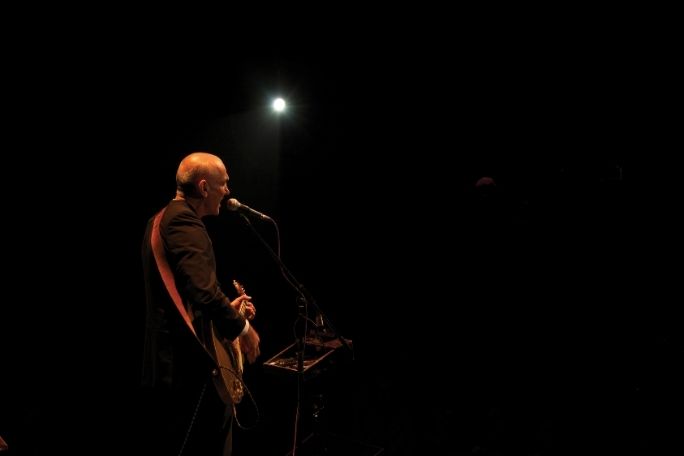Lesson summary
This lesson continues from Biography – Part 1. Portrayal of character is explored through a brainstorming activity then applied to the sections of the documentary. Students explore the text features of biography and narrative and study the opening scene of the film to investigate how a filmmaker can framed a subject. Using the jigsaw group investigation method, students investigate some of the film techniques used throughout the opening scenes and analyse their effects. A class brainstorm firms up student ideas about framing the subject, which are then further developed through a persuasive writing task.
This lesson uses sections of Shark Island Productions’ Paul Kelly – Stories of Me as learning stimuli. Teachers are required to create an account to view the film and use the supplied code to enable students to access the film.
Key points to explore:
- A character can be portrayed in a text in a variety of ways.
- Biographic and narrative text types share similarities and differences.
- A filmmaker consciously frames their subject using different techniques.
- Musicians create their own image.
Lesson guides and printables
Lesson details
Curriculum mapping
Australian Curriculum content descriptions:
Year 9 English:
- Listen to spoken texts constructed for different purposes, for example to entertain and to persuade, and analyse how language features of these texts position listeners to respond in particular ways (ACELY1740)
- Understand that authors innovate with text structures and language for specific purposes and effects (ACELA1553)
- Use comprehension strategies to interpret and analyse texts, comparing and evaluating representations of an event, issue, situation or character in different texts (ACELY1744)
- Create imaginative, informative and persuasive texts that present a point of view and advance or illustrate arguments, including texts that integrate visual, print and/or audio features (ACELY1746)
Year 10 English:
- Analyse and evaluate how people, cultures, places, events, objects and concepts are represented in texts, including media texts, through language, structural and/or visual choices (ACELY1749)
- Identify and explore the purposes and effects of different text structures and language features of spoken texts, and use this knowledge to create purposeful texts that inform, persuade and engage (ACELY1750)
- Identify, explain and discuss how narrative viewpoint, structure, characterisation and devices including analogy and satire shape different interpretations and responses to a text (ACELT1642)
- Create sustained texts, including texts that combine specific digital or media content, for imaginative, informative, or persuasive purposes that reflect upon challenging and complex issues (ACELY1756)
Year 11 English:
Unit 1
Investigate the relationships between language, context and meaning by:
- evaluating the choice of mode and medium in shaping the response of audiences, including digital texts. (ACEEN003)
Examine similarities and differences between imaginative, persuasive and interpretive texts including:
- explaining the ways language features, text structures and conventions communicate ideas and points of view (ACEEN004)
- explaining the ways text structures, language features and stylistic choices are used in different types of texts (ACEEN005)
Create a range of texts:
- using appropriate form, content, style and tone for different purposes and audiences in real and imagined contexts (ACEEN011)
- drawing on a range of technologies in, for example, research, communication and representation of ideas (ACEEN012)
- combining visual, spoken and written elements where appropriate (ACEEN013)
- using evidence-based argument (ACEEN014)
- using strategies for planning, drafting, editing and proofreading (ACEEN016)
- using accurate spelling, punctuation, syntax and metalanguage. (ACEEN017)
Compare texts in a variety of contexts, mediums and modes by:
- analysing the style and structure of texts including digital texts (ACEEN022)
Investigate the representation of ideas, attitudes and voices in texts including:
- analysing the ways language features, text structures and stylistic choices shape points of view and influence audiences (ACEEN024)
Create a range of texts:
- selecting and applying appropriate textual evidence to support arguments (ACEEN035)
- using strategies for planning, drafting, editing and proofreading (ACEEN036)
- using accurate spelling, punctuation, syntax and metalanguage. (ACEEN037)
General capabilities: Literacy, Critical and Creative Thinking, ICT Capability.
Unit of work: PAUL KELLY – STORIES OF ME
Time required: 180 minutes (or 3x 60 minutes)
Level of teacher scaffolding: Medium – facilitate student discussion, coordinate student movement around classroom.
Resources required
- Student Worksheet – one copy per student OR computers/tablets to access the online worksheet
- Device capable of presenting a website to the class
- Copy of Paul Kelly – Stories of Me (teachers are required to create an account to view and invite students to view the film), Persuasive essay graphic organiser
- Sticky notes
- Collage making materials or the online collage maker
- Printed out and cut up sets of the ‘Biography or Narrative’ Matching Activity (enough for small groups)
- Mind-map web tools mindmeister or bubbl.us
Additional info
This lesson uses sections of Shark Island Production’s Paul Kelly – Stories of Me as learning stimuli. Teachers are required to create an account on the film’s website to view the film. Upon registration you will be given a code – give this to your students so that they can access the film too.


Welcome back!
Don't have an account yet?
Log in with:
By signing up to Cool.org you consent and agree to Cool's privacy policy to
store, manage and process your personal information. To read more, please see
our privacy policy here(Opens in new tab).
Create your free Cool.org account.
Many of our resources are free, with an option to upgrade to Cool+ for premium content.
Already have an account?
Sign up with:
By signing up to Cool.org you consent and agree to Cool's privacy policy to
store, manage and process your personal information. To read more, please see
our privacy policy here(Opens in new tab).